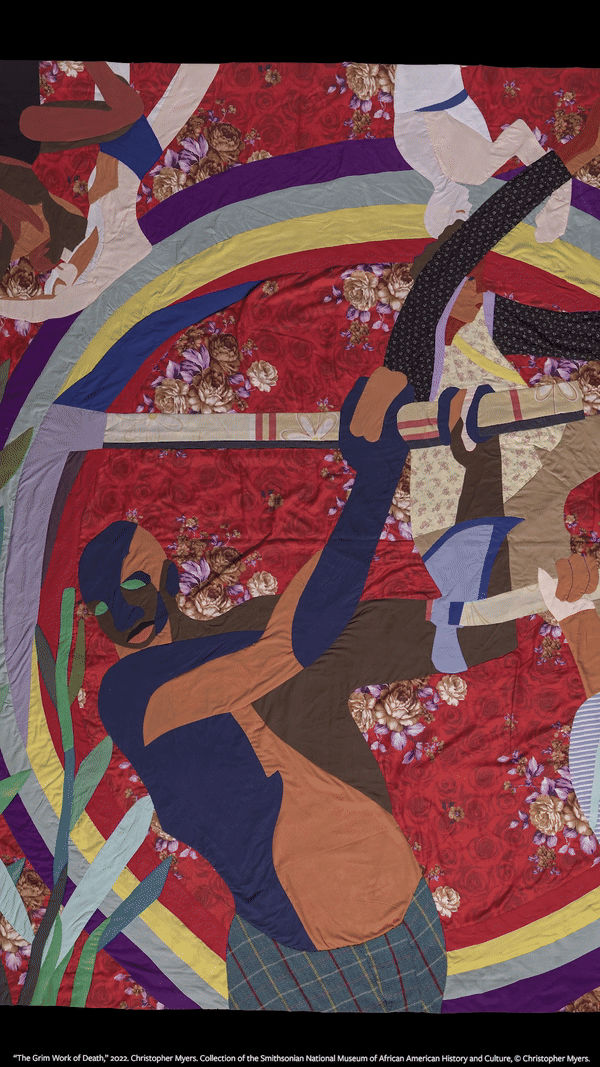“The Grim Work of Death” by Christopher Myers. Collection of the Smithsonian’s National Museum of African American History and Culture.
Nat Turner’s Slave Rebellion Portrayed in Striking Artwork at the Smithsonian’s National Museum of African American History and Culture

“The Grim Work of Death” by Christopher Myers. Collection of the Smithsonian’s National Museum of African American History and Culture. Copyright Christopher Myers.
The Smithsonian’s National Museum of African American History and Culture (NMAAHC) now has on view a larger-than-life, vibrant depiction of Nat Turner’s slave rebellion by artist Christopher Myers. The tapestry, titled “The Grim Work of Death,” is a monumental artwork and visual journey containing 32 feet worth of history and mythology surrounding Turner’s slave rebellion. An important addition to the museum, the tapestry can be found on NMAAHC’s Concourse Level Sept. 24. For more information about this artwork, visit the Searchable Museum.
“Art has a way of bringing history to life in riveting ways,” said Kevin Young, the Andrew W. Mellon Director of the National Museum of African American History and Culture. “‘The Grim Work of Death,’ a 2022 tapestry by Christopher Myers, is stunning in its power to create a visual journey into the complex life and legacy of Nat Turner.”
Turner was an enslaved man who believed that he was called by God to deliver his people from slavery. Through preaching, Turner empowered fellow enslaved African Americans to revolt, and Turner’s Rebellion officially began Aug. 21, 1831. The rebellion resulted in the deaths of more than 50 people in Southampton County, Virginia, before a militia force stopped it. Afterward, Turner remained free for six weeks before he was caught by authorities and sentenced to be hanged. Turner’s rebellion is considered to be one of the most successful uprisings against slavery in the United States. It inspired a chain reaction of similar revolts throughout the region.
Myers, a contemporary artist from Brooklyn, New York, took the name of the artwork from Turner’s own description of his and his compatriots’ efforts. “Turner’s life is indicative of the crossroads and intersections all of us inhabit….I offer this portrait of a man caught in the whirlwind of history, in a confluence of ideas and concepts, as are we all,” Myers said.
In 2022, Myers commemorated Turner’s life and legacy by creating this tapestry, which combines historical investigation with mythological storytelling. The engaging and stunning tapestry is composed of a multitude of colorful fabrics, many of which are handsewn. In his bold, complex style, Myers stitches together various aspects of the rebellion’s narrative.
Myers includes the literal instruments of death—farm tools, axes, picks and hammers—as well as mythological and religious motifs in the work. Several of the figures and design elements reference Turner’s prophetic visions that inspired his rebellion. Throughout the tapestry, viewers may spot epic battle scenes between Black and white figures, a pale face crying tears of blood, a mouth of an African American sewn shut and more.
This new work joins NMAAHC’s vast collection of culturally engaging objects. It enhances ongoing efforts to reimagine African American history and freedom, as currently seen in its permanent exhibitions and the museum’s “Reckoning” exhibition.
About the National Museum of African American History and Culture
Since opening Sept. 24, 2016, the National Museum of African American History and Culture has welcomed 11 million in-person visitors and millions more through its digital presence. Occupying a prominent location next to the Washington Monument on the National Mall in Washington, D.C., the nearly 400,000-square-foot museum is the nation’s largest and most comprehensive cultural destination devoted exclusively to exploring, documenting and showcasing the African American story and its impact on American and world history. The museum has also launched and is continually expanding its reach with the Searchable Museum portal and other efforts to bring African American history into the world’s hands and homes. For more information about the museum, visit nmaahc.si.edu, follow @NMAAHC on X, Facebook and Instagram or call Smithsonian information at (202) 633-1000.
# # #
SI-308-2024

